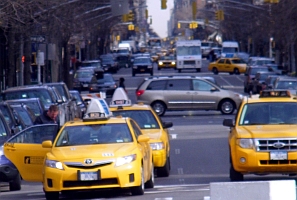Psychologists and engineers at University of Toronto in Ontario, Canada found adding high speed Internet connections to cars creates potential distraction risks to drivers, even when used with hands-free voice-controlled devices. The team led by Toronto psychologist Ian Spence published its findings in the September-October 2013 issue of the journal Applied Cognitive Psychology (paid subscription required).
In September 2013, Canadian wireless provider Rogers Communications and the U.S. wireless network Sprint announced high speed Internet services for cars in Canada. A Rogers executive called it “the ultimate connected car experience on the road, with a combination of smartphone, tablet, and in-dash capabilities.” Services provided are expected to include infotainment (e.g., news and weather), navigation, climate control, security, emergency services, and vehicle diagnostics.
The study tested the ability of subjects to pay attention under conditions similar to driving in cars with high-speed Internet services. Spence and colleagues asked participants to identify random locations of objects in a cluttered visual field on a computer monitor, in a simulation of focus and attention needed while driving. Subjects were asked to perform this task either in silence, or while simultaneously conducting listening or speaking tasks.
The listening or speaking tasks undertaken while identifying the objects on the monitor ranged from passive listening, much like listening to the news on a car radio, to more demanding exercises: answering yes/no questions — either by thinking of the answer or saying it out loud — and being asked to speak out loud a word starting with the last letter of a word spoken to the subject.
The Toronto team found study participants performing speaking and listening tasks were able to complete the visual identification tests with the same accuracy as those who conducted the tests in silence. But the speaking and listening participants took more time to perform these visual identification tests, needing almost an entire second to perform the most demanding cognitive tasks.
Even at moderate speeds, the slower reaction times could pose a danger for drivers, to other vehicles, and to pedestrians. “At 50 kilometres per hour (31 miles per hour), a car travels 13.9 metres (15.2 yards) in one second,” Spence notes in a university statement. “A driver who brakes one second earlier than another driver to avoid a collision, will either prevent it completely or be travelling more slowly when it occurs, lowering the probability of severe injury or fatality.”
And as Spence explains, “It did not matter whether the subject spoke the answer aloud or simply thought about the answer. It was the thinking, not speaking, that caused them to slow down.” Because the subjects’ slower reaction times are about the same when thinking and speaking led the researchers to conclude, “An impairment of this magnitude presents a significant threat to safe driving and calls into question the belief that hands-free voice-controlled devices are the answer to the problem of driver distraction.”
Read more:
- Traffic Intersection Study Pinpoints Stoplight Danger Zone
- Headphone-Wearing Pedestrian Injuries Triple Since 2004
- Ford to Open Silicon Valley Research Lab
- Algorithm Predicts Auto Traffic Intersection Violators
* * *


 RSS - Posts
RSS - Posts
You must be logged in to post a comment.